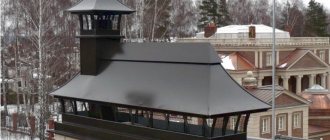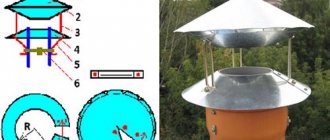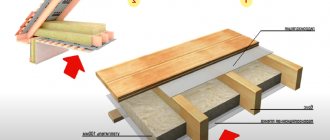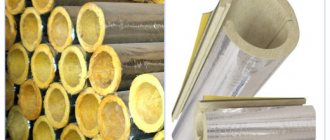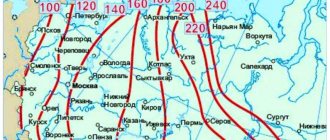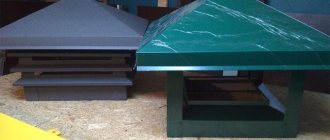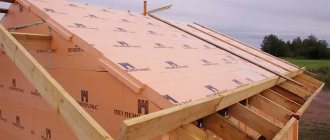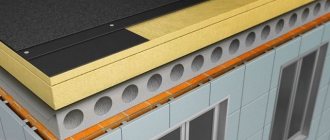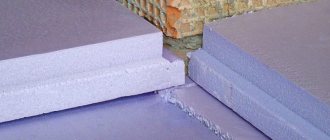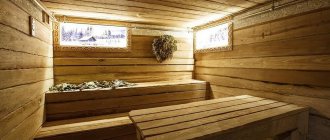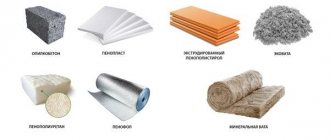Why do you need to insulate the chimney?
Effective insulation of the chimney will prevent it from cooling quickly.
In addition, traction improves and the likelihood of condensation formation decreases.
Insulation of the chimney is indirect, but still prevents heating of the building structures.
Basically, measures for insulating chimney pipes are carried out with the chimneys of gas boilers.
Why is it important to insulate the chimney?
Chimney insulation is necessary for the following reasons:
- Fire prevention, because when a chimney passes through various types of coverings (walls, floors and ceilings), a fire may occur.
- With sudden temperature changes, the material from which the chimney is made may begin to collapse. A similar thing can happen as a result of the formation of various acids and alkalis during the combustion process. They can destroy not only the pipe itself (this factor applies mainly to metal products), but also everything that surrounds it: walls, floors, ceilings.
- The rapid heating provided by the chimney, against the backdrop of a rapid increase in temperature in the room, negatively affects things and furnishings in the room, including humans, so thermal insulation will help prevent this adverse effect and ensure normal regulation of heat exchange.
- Reduce the release of condensation that appears due to temperature differences during the heating process. The released moisture forms harmful chemical compounds, reacting with many other substances contained inside the pipe.
Important! The main goal of providing high-quality thermal insulation to pipes is to minimize the risks of harm to human health, things and directly to the structural materials of the room.
Foil materials: structure and principle of operation
Even people far from construction have at least once encountered insulation that is shiny on one side; the name of one or another of its varieties is known to owners involved in construction or repair. Such materials are often called two-layer, because of the conspicuous metal (reflective) layer; There are options coated with a reflective layer on both sides.
The bottom (or inner) layer is made of a porous or fibrous material. It serves as thermal insulation and serves as a strong base for the foil. The foil component, glued on top of the insulation, is needed to reflect infrared (thermal) radiation. It is made of aluminum foil or metallized film, different in properties:
- Aluminium foil . It is applied by heat welding and polished to the desired reflectance (95%). The foil is destroyed by the salt contained in the cement mortar.
Foil retains heat in the room Source otoplenie-gid.ru
- Metallized film . Apply to one or two sides of the material. It reflects less heat, but is resistant to alkaline influences.
Each layer has its own “responsibilities”. The foil reflects thermal energy, and does it effectively: according to manufacturers, up to 90-95% of thermal radiation is returned. The remaining percentage is partially absorbed by the insulation, and partially the heat is dissipated in space.
Attention! Practical measurements have shown that the efficiency of foil thermal insulation is 30-60% higher than that of a similar single-layer thermal insulation material. It is important that the price difference is not so significant; In the long term, this means savings on heating.
Foil underfloor heating reduces heat loss Source veralline.com
Positive factors of an insulated chimney
After building a house, carrying out work on roof insulation, and insulating it, it’s time to start waterproofing the channels. There are several positive aspects to such work, which we will look at later. So, insulating a chimney pipe allows you to:
- Reduce thermal energy consumption, it is noticeably reduced.
- Preserve and secure the passage through the roof itself.
- Ensure high wear resistance of the structure.
- Create a certain interior style without relying on a pipe.
In principle, this work should not cause any particular difficulties, but it is still worth understanding that in order to properly insulate, you need to choose the type of insulation that is suitable specifically for your home and performs the functions assigned to it.
Cellular materials
Cellular non-combustible insulation is similar in structure to foam. A large number of closed cavities with air causes low thermal conductivity.
Foam glass has good thermal insulating properties, which does not change for 100 years and does not absorb moisture. Foam glass, obtained by sintering broken glass with solid gas-forming agents, is used to make panels and housings for laying pipes. Foamed glass is an ideal non-flammable insulation for deep basements in wet soils.
All presented heat-insulating products have clearly expressed non-flammable properties. Thermal stability is due to mineral raw materials.
Materials for insulation of chimney pipes
It is advisable to start a project for insulating chimney pipes at the time of construction of a house or cottage, but thermal insulation work can be carried out at any stage, even if the dwelling has already been built. Next, we will consider the main methods, methods and materials that are suitable for carrying out this procedure.
The integrity of the chimney pipe is affected by two main factors that must be taken into account during insulation work:
- Dew point. This point concerns the release of condensate, the negative impact of which was discussed above. The fact is that in the absence of proper thermal insulation, the dew point moves inside the pipe. That is, the warm air that rises during the heating of the room rises up from the direct heating source, reaches a certain point inside the chimney, and settles there in the form of condensate drops. This is especially dangerous for metal and brick products, since excess moisture is absorbed by the material and destroys it from the inside, freezing and turning into ice;
- aggressive negative impact of gases released from combustion. During the heating process, harmful chemical compounds inevitably appear, which destroy the entire home heating system. This especially applies to weak acidic solutions of nitrogen or sulfur. With prolonged exposure, they can destroy a chimney made of almost all materials.
To protect yourself from such harmful factors, you can choose one of the following insulation materials:
- non-flammable insulation for chimneys made of slag wool;
- glass wool;
- basalt wool.
The most popular and widely used are thermal insulators made of basalt wool.
This version of fire-resistant insulation for chimney lining is available in two forms: in rolls and mats. It also varies in density and size, depending on the individual characteristics of the pipe, the purpose of the lining and other design factors, which are taken into account separately in each specific case.
Their main feature: preservation of structure and properties even with strong heating up to +400°C. They are fire-resistant and non-flammable, therefore reducing the risk of fire to a minimum.
Metallurgical slags are used as raw materials for production.
The disadvantages of this material include:
- presence of residual acidity;
- the possibility of a hostile environment occurring when moisture gets on the material.
Despite these negative aspects, this fire-resistant chimney insulation is widely used in repair and insulation work, as it maintains an ideal price-quality ratio.
Glass wool is an insulating material with a fibrous structure. It is produced from broken glass or raw materials used during glass melting.
Depending on the manufacturing method, glass wool is divided into:
- thin, which is obtained by spunbonding (pulling) from glass melt;
- rough through the blowing method.
Glass wool is sold in the form of rolls or slabs.
Basalt rocks are used as raw materials for the production of insulation.
- The method of using inorganic elements provides complete resistance to rotting and fungi.
- Basalt wool for chimneys has high strength and heat resistance, so it is preferred to be used as non-combustible thermal insulation to prevent fire inside the chimney.
- The insulator fits well and adapts to the insulation surface. Has a long service life. After installation, it serves without loss of its characteristics for 30-40 years.
- Based on strength, basalt wool is divided into: soft, semi-rigid and hard.
Basalt wool has an additional useful property in the form of protection against moisture, therefore it is a more universal method of thermal insulation in comparison with glass wool or slag fiber.
Fireproof thermal insulation for walls
Applying liquid polyurethane foam to walls.
Ideally, non-flammable wall insulation should always be used when it comes to thermal insulation of load-bearing structures. According to the rules of heating engineering, work should be carried out from the outside and only as a last resort from the inside. For these purposes, the choice of materials is quite wide:
If previously the most popular non-flammable insulation for walls was mineral wool, today it has greatly lost its position in favor of modern liquid thermal insulation. We are talking about polyurethane foam and penoizol, and insulating paint, although it is positioned as a non-flammable insulation for the facade, is in fact only suitable for thermal insulation of communications.
Bulk materials for horizontal structures are applicable not only during construction, when they can fill the space between walls. After the structure is erected, it can be blown out through the holes made in the wall. Bulk non-flammable thermal insulation for walls fills all the cracks, in principle, like liquid insulation, but the latter has its advantages:
- it is lighter; lower thermal conductivity coefficient; reasonable price; possibility of application to a wall, for example, on a facade.
Foam glass is still the most expensive material among fireproof thermal insulation.
It comes in granules, stones (like crushed stone) and blocks. Granules and blocks are used for walls. The former are filled into inter-wall cavities, and the latter are used to construct protective structures on the façade side.
The blocks are quite strong, but still cannot act as load-bearing elements. Due to their high cost, such materials are used only on large objects. They are almost never used for private houses, since the insulation will turn out to be simply golden.
After cleaning the heat exchangers, the liquid for heating radiators must be neutralized with a special solution and only then poured into the sewer. Non-freezing liquid for a heating system in a warm house only thickens even at -60. You will find its characteristics here.
Chimney insulation design
The insulated chimney has a sandwich-like appearance. This design includes two pipes - external and internal, between which there is basalt insulation for chimney pipes.
Such a structure will help prevent the formation of condensation. In the manufacture of the inner pipe, which bears heavy loads from the interaction of combustion products, high-quality steel is used.
The outer pipe is decorative. For its manufacture, copper, stainless steel or any other material coated with colored enamel is used.
But with an industrial chimney everything is a little different. As a thermal insulation material, you need to use insulation that can withstand temperatures up to 4,000 degrees.
Such material should also provide protection for the outer skin, since the constant influence of temperatures and temperature changes can negatively affect the outer (cement) layer.
How to insulate a coaxial chimney of a gas boiler?
In winter, many owners of private houses have to deal with the problem that the coaxial chimney freezes. In such situations, you have to look for ways to insulate a coaxial chimney.
p, blockquote 25,0,0,0,0 —>
However, experts advise resorting to another method - reducing the size of the chimney. If the tip freezes due to condensate entering the air intake pipe from a pipe with combustion products, then the length of the inner pipe must be adjusted to the size of the outer one.
p, blockquote 26,0,0,0,0 —>
It is best to install two separate pipes and insulate them, because... an insulated coaxial structure is unlikely to save the situation.
p, blockquote 27,0,0,0,0 —> p, blockquote 28,0,0,0,1 —>
As you can see, insulating a chimney is not such a difficult task. You just need to select all the materials correctly and follow the work technology.
Fireproof thermal insulation: oxygen index of the material
The oxygen index of insulation is the degree of fire safety of a material, indicating the minimum amount of oxygen per unit volume of insulation.
The oxygen index has several flammability thresholds:
- 40% – high level, composite polymers;
- 31% – cellular and fibrous and non-combustible insulation;
- 20% – building materials that burn well in air.
When choosing insulation for your needs, first of all you need to pay attention to this indicator.
Features of thermal protection products
When choosing non-flammable raw materials for construction work, you should pay attention to its characteristics, composition and features. Depending on these indicators, a means of insulating the floor, ceiling, pipes or other structures is selected.
The defining characteristic of the raw material for insulation is also its thickness. This indicator influences the choice of heat-insulating material for highways, air ducts and other structures that require precise calculations during their construction. Density and weight also influence the choice; the calculation of the load on the floors of structures depends on these indicators.
How to make non-flammable thermal insulation of chimneys
When fuel burns in stoves and fireplaces, carbon monoxide is formed. They are removed through the chimney. Despite its apparent simplicity, this design is complex. Chimneys are installed to provide the necessary draft, so they should be correctly brought to the roof, the height determined and connected to the roofing. Properly made thermal insulation for chimneys is also important.
Furnace gases escaping from the furnace to the outside have a high temperature. When they rush up the chimney channel, condensation forms on its inner walls. This leads to the following problems:
- if moisture is absorbed into the chimney material, it will deteriorate over time;
- sometimes droplets of water settle on the surface of the outlet channels, which reduces their permeability and allows smoke to leak into the room;
- when condensate constantly flows down the walls of the chimney, smudges, hanging drops and an unpleasant odor appear.
Thermal insulation of the chimney helps to avoid these troubles and extends its service life.
Note! The chimney is insulated to prevent rapid cooling. If you do it incorrectly, you can’t count on a positive result.
How to isolate the furnace channel depends on the material from which it was made. You can make insulation using:
- crushed bricks;
- slag;
- expanded clay;
- basalt or mineral wool;
- kaolin, etc.
After installing the containment shell, the smoke exhaust structure is lined. For this purpose it is used:
- brick;
- slag concrete and reinforced concrete slabs;
- galvanized metal casings;
- wooden boards;
- profiled sheet, etc.
On a note! The easiest way is to buy a ready-made insulated sandwich pipe and install it at the stage when the chimney is being built.
Let's take a look at some thermal insulation options separately.
Basalt wool insulation
This method of protecting chimneys is attractive due to its accessibility and is therefore used more often than others. Basalt wool has a thickness of 20-100 mm and can withstand temperatures up to 750 degrees. This fire-resistant material is wrapped in several layers around the pipe and secured with wire. A layer of plaster is applied on top.
Lining the chimney with stainless steel sheets is done in the following order:
- measure the perimeter of the pipe, including insulation;
- cut a piece of sheet steel up to one meter long and a width equal to the perimeter of the structure plus an allowance for fastening;
- round the sheet and finish the edges with a roller;
- put the resulting form on the stove chimney, pull it together and fasten it with metal screws;
- In the same way, install several more metal casings on top of each other (make sure that the seams run at an angle of 120˚).
On a note! If you do not use steel casings, the insulation will not last long and you will have to replace it. Even if you insulate the chimney with foil or film, they will not be able to prevent moisture from penetrating into the basalt wool.
Applications of kaolin
Another method of thermal protection of chimneys is the use of kaolin. The material is characterized as:
Work on installing non-flammable thermal insulation for chimneys is carried out in the following order:
- first plaster the stove channel;
- then glue kaolin sheets to the wet plaster;
- Finally, sew up the chimney with facing material.
Insulation with mineral wool
Thermal insulation using mineral wool is done as follows.
- Build a metal profile sheathing around the chimney. The profile size is selected depending on the thickness of the insulation, and the lathing pitch depends on the width of the insulating sheets.
- Attach mineral wool to the profile in several layers (do not forget to space the seams).
- Wrap the finished structure with vapor barrier film and seal the joints with tape.
Note! Sheets of metal corrugated sheets can be used as finishing. They are fixed to the sheathing using special screws with rubber gaskets.
How to insulate a chimney also depends on the material from which it was made.
Thermal insulation of steel pipes
The chimney, made of a round steel pipe, is insulated using a ready-made metal case. Large diameter galvanized pipe is suitable for this purpose. The difference in the diameters of the chimney and insulation is 16-20 cm. Thermal insulation is installed in this way.
- Place the casing on the steel chimney.
- Pour expanded clay, broken brick or slag into the space formed between the elements. You can also compact mineral wool, basalt wool or fiberglass between the pipes.
- Fill the open area with cement mortar, waterproof it and install a protective casing on top.
On a note! The profile steel pipe is sheathed using wooden panels or metal sheets (corrugated sheeting). The distance between the components of the structure is 8-10 cm. The space is filled with insulation and securely sealed on top.
Insulation of brick chimney
In this case, preference is given to mineral wool, which is attached as follows:
- cut out pieces of insulation the size of which corresponds to the area of the side walls of the pipe;
- attach the blanks to the brick using plastic dowels with round heads, or use tape (this option is lightweight, but not reliable);
- cover the attached material with asbestos-cement slabs, corrugated sheets or bricks.
Important! To reduce heat loss, plaster the brick on the outside of the channel, and then cover it with a frost-resistant compound.
Thermal protection of asbestos-cement pipes
Insulating chimney pipes from asbestos cement is done like this.
- First, clean the outer surface of the chimney from dust and dirt.
- Make a folding metal casing consisting of two halves. When assembled, its diameter should be 12-16 cm larger than the diameter of the pipe. The height of the case can vary within one meter.
- Place the bottom galvanized casing on the chimney.
- Fill or compact protective material into the resulting space.
- Install the next case and reinstall the insulation.
- Cut the top casing together with the asbestos cement pipe at a slight angle.
- Cover the insulation with a thin layer of cement mortar.
On a note! If you do not install a metal case, the mineral wool will become wet, heavy, crumpled or frayed in the wind. Birds, rodents or cats also take away the insulation.
Insulation of the chimney in the ceiling
When a metal chimney passes through a wooden ceiling, the distance between them must be at least 30 cm. If the chimney is lined with brick, then this value is reduced to 10 cm. The opening is filled with basalt wool and closed from below and above with a metal sheet. Make sure that the chimney is securely fastened to the ceiling.
Thermal insulation for chimneys: types of insulation and methods of protecting chimneys, Portal about pipes How to insulate a chimney - non-flammable thermal insulation. What materials are used to insulate chimney pipes in the ceiling? Methods and nuances of insulating structures made of
Do-it-yourself insulation installation
Before starting work, you need to learn the basic rules for applying insulation, and learn how to insulate an iron chimney pipe yourself. Insulation carried out according to the rules will allow the owner not to violate the construction technology and not worry about reducing the draft in the chimney.
Required tools and materials
For installation work on insulating a chimney pipe from the outside, you will need a set of tools that are available in every household: a tape measure, a screwdriver, a grinder, self-tapping screws, metal scissors, a knife for cutting insulation, and protective equipment.
Calculation of the dimensions of the structure
To properly organize the work, you need to calculate the construction parameters and costs. The heating temperature of the inside of the outlet channel, as well as the insulating layer, depend on what type of fuel is used.
The amount of insulation is calculated according to the measurements taken:
- external parameters of the insulated surface;
- height of the structure;
- distance from the lower outlet of the pipe.
For example: on a cold roof and above it, the outlet from a solid fuel heater is wrapped with a layer of 5 cm to 10 cm. The distance on the chimney from the ceiling to the roof in an insulated attic is insulated with a layer of up to 6 cm. The exhaust structure from a gas boiler is insulated with a layer of 3 cm.
The insulation consumption for a chimney for a solid fuel boiler will be, for example, as follows: with its height of 5 m, diameter 219 cm, basalt cylinders need 5 linear meters with a layer thickness of 5 cm, parameters for the internal diameter. Sheet insulation will require 3.5 m². For the protective casing, buy galvanized steel, 2.7 cm thick.
The height of the protruding end depends on the distance of the channel to the roof ridge. Located at a distance of 1.5 m from the center of the house, the chimney should be 50 cm higher than the ridge. Two meters from the center - the height at the level of the ridge, three meters on pitched roofs - the height is determined at an angle of 10°, between the line of the horizon and the ridge.
Work progress
Before installation, you will need to buy chimney sections, anti-corrosion agent, insulation, brackets and clamps, heat-resistant sealant, moisture-proof fabric, galvanized cladding, profiles for the frame, asbestos sealant, fire-resistant foam.
- Before using the insulation, an anti-corrosion substance is applied to the pipe. A protective film is formed on the surface, which protects the metal from destruction for a long time. Combine and secure the parts of the pipe so that moisture does not enter the joints when draining. The connection should be 5-7 cm long for stability.
- After connecting the segments, the metal pipe is wrapped with insulation. The edges of the insulation are wrapped overlapping and secured with steel clamps or aluminum wire. Externally insulated wire cannot be used. Under the influence of high temperatures, the insulation will melt, the fastening strength will weaken, which will lead to deformation of the winding.
- The soft surface is covered with a vapor barrier fabric, and sheets of galvanized steel are fixed on top of it. The galvanizing is fixed with an overlap, from bottom to top, with an overlap of 7-10 cm, fixed with clamps every 30 cm.
- A hole is cut in the roof, which corresponds in diameter to the insulated chimney.
- Under the roof and on the outside of the ceiling to the rafter structure, a horizontal fastening is installed to stabilize the chimney.
- The gaps between the roof and the structure are sealed with heat-resistant non-combustible materials, blown in with heat-resistant foam, and covered with a metal casing.
Safety when insulating a chimney at height
Before insulating a metal or any other pipe, you need to inspect the workplace to assess possible risks in order to minimize them. A ladder prepared in advance and tested for strength, boards for flooring over slate or tiles, strong, proven ropes - all this will ensure your safety during the work.
When laying boards on slate, observe the following rule: boards are laid across the waves. If you don’t have an industrial safety harness, make one from strong, thick rope or belt.
One end of such insurance must be firmly attached to a strong, fixed structure of the house or roof.
Clothing should not be unbuttoned, have drooping sleeves or a dangling collar, but it is best to use overalls.
When laying a chimney pipe through the thickness of the ceiling, do not skimp on insulation - lay it in this place, even if the ceiling material is non-flammable: heated concrete can ignite the decorative finishing of the ceiling.
You don’t have to lay basalt or mineral wool next to the stove or heating boiler, but such areas should be no more than 50 cm wide.
If the insulation material is able to withstand high temperatures (read the instructions for it), then it is better to lay it in these places.
Insulate yourself or call a professional
It is better to entrust the laying of a fireplace chimney, stove or installation and connection of a gas boiler to specialists.
Thermal insulation work itself is a completely feasible task for any owner. Before starting work, it is important to understand the essence of the physical processes leading to the destruction of the structure and choose the right insulation.
Non-combustible thermal insulation: insulation of brick, asbestos-cement pipes, stainless steel chimneys
The need to insulate high-temperature routes has arisen since their inception. And if the insulation of pipelines was solved quite simply - they were buried in the ground, then the insulation of chimney pipes caused a number of difficulties. And they were associated primarily with the danger of fire of the heat insulator itself. This is why non-flammable thermal insulation for chimneys is a priority when choosing insulation.
For information! In some sources you can read that such a layer is possible without reinforcement, but I would still like to remind you that reinforcement is an element of strengthening, and the layer that you leave will serve as a shield for the pipe, while independently taking on themselves against all temperature fluctuations and aggressive atmospheric influences. Therefore, the stronger the structure, the longer and without problems it will serve.
Next comes the application of the plaster itself, which must be prepared in two consistencies: pasty and more liquid. Layers are applied one after another, the last being a thick layer, which is leveled and whitened with regular whitewash.
Also suitable for a brick wall are basalt wool mats, foam glass and any other non-flammable thermal insulation material, and the technology will be as follows:
- The pipe is wrapped in insulation: either mats of basalt wool (foam glass) are attached to umbrellas, or a roll is wrapped around the pipe and fixed with wire;
- Next, either prepare another brick box around the pipe, followed by sealing the gap between the main pipe and the casing with cement mortar;
- Either the insulation is wrapped in foil, the lower joining part is cemented to form a cement pad, the joints and seam part are closed with special foil tape.
Insulation of brick pipes is as follows:
- At the end of all work, we need to get a layer of 5 cm, this will be quite enough for pipes, so we clean the pipe itself from dirt and unstable layers and reinforce it with a coarse metal mesh;
- All the technologies we have described are quite simple, one might say economical, and easy to do with your own hands.
Pipes made of so-called stainless steel
The same materials are used for steel chimneys as for asbestos-cement pipes. Laying technology, materials, fastenings, all this is reminiscent of the previous chapter. Only in this case there are ready-made solutions that you can choose and not suffer. These are the so-called sandwich systems, when the pipe is already in the pipe, and non-combustible insulation is inserted between them.
General recommendations for carrying out work
Warming is a necessary process.
Whatever technologies you choose for insulation, there are general recommendations that, for some reason, are lost in the general cacophony of advice, but which are still worth listening to in order to avoid many embarrassments. So:
- As you have noticed, in all works it is proposed to seal the bottom edge in a cement base, before carrying out such work, make sure that the roof base allows it to be done;
- When carrying out insulation, keep in mind that neither the insulation nor the casing (if any) should come into contact with the roof. That is, it is necessary to think through the docking and drainage system;
- When purchasing adhesive mixtures for fixing the same basalt wool or foam glass, as well as adhesive tape for fixing insulation, pay attention first to the area of application, and then to the price, and not vice versa. The fact is that heat-resistant materials will initially be more expensive than conventional ones;
- When choosing a thermal insulation material, consult the seller about the possibility of using the material. Although the material is imported specifically for your region, sometimes thinner insulation is left behind. Just keep in mind that for insulation work, a material of at least 40 mm is required;
- More complete information may be in the accompanying documents for the material, as well as on the packaging, the official website of the manufacturer, do not be lazy to look at the information.
Non-combustible chimney insulation
Only mineral wool is used to insulate the chimney.
Why insulate the chimney, because it is already hot? Let's start with the fact that it only needs to be insulated outdoors or in an unheated room. It is not necessary to do this indoors, although it is not prohibited.
The most common non-flammable insulation for chimneys is mineral wool in rolls (glass wool, basalt wool). It can withstand high temperatures, does not burn or smolder, and therefore does not emit any toxic gases. Also read: “How to insulate a chimney pipe.”
Non-flammable thermal insulation for pipes is needed to prevent condensation from forming in the chimney due to the temperature difference between the exhaust gases and the air outside. The presence of condensation leads to the following consequences:
- destruction of the chimney; failure of the boiler; icing.
The greater the thickness of non-flammable thermal insulation for pipes, the more effective the insulation, and at the same time the temperature difference and the amount of condensate are minimized.
It is not recommended to use materials thinner than five centimeters. Rolled insulation is wound around the pipe with a slight overlap and secured with soft wire.
The external insulation must be protected with foil or sheet metal. There are ready-made steel sandwich chimneys on sale, which consist of two tin pipes of different diameters, with mineral wool between them. Remember that non-flammable pipe insulation is afraid of moisture and, having absorbed it, loses its heat transfer resistance characteristics.
Chemically active liquid for flushing heating boilers is also suitable for cleaning pipes and radiators. Along with dirt, it also corrodes rust, so often after work is carried out, a leak appears in the system. You can read about what kind of antifreeze liquid to pour into the heating system here.
Brands of basalt insulation for chimney insulation
Various manufacturers offer consumers more than several dozen types of basalt insulation materials. Some are manufactured abroad, others at domestic enterprises.
Judging by customer reviews, the products of the following companies are popular:
- Rockwool basalt wool is manufactured at the enterprises of the company of the same name, located in Denmark. In terms of its characteristics: hydrophobicity, sound and heat insulation, as well as mechanical strength, Rockwool is significantly ahead of analogues from other manufacturers. Rockwool basalt wool is used by manufacturing companies to insulate finished ceramic chimneys from Schiedel, Effe2 and others.
- URSA basalt wool – originally manufactured in Italy. Today the company has 14 large production centers located in Europe, the Middle East and Asia, which as a result could not but affect the quality of the products. The URSA company specializes in insulation of industrial and domestic premises, and is popular due to the good price-quality ratio of its products.
- Izovat basalt wool is an insulation material manufactured in neighboring countries, in Ukraine. The product range includes mineral boards with densities from 30 to 200 kg/m³. It is worth paying attention to the brand intended for insulating brick chimney ducts with subsequent plastering of the surface. The thickness of Izovat slabs is from 30 to 200 mm.
- Basalt wool Paroc is a Swedish company that has been specializing in the production of stone wool since the 30s of the last century. Paroc production facilities are located exclusively in EU countries, which allows us to maintain a high level of quality and full compliance with safety standards in force in Europe.
- Paroc basalt cylinders can be used to insulate iron chimney pipes. For this purpose, the company has developed the Paroc Pro Section and Paroc Pro Bend + covering layer series, which provide maximum thermal insulation and protection of steel structures.
When choosing basalt for pipe insulation, you should mainly focus on the thermal characteristics specified by the manufacturer. On the basis of large concerns, modifications specifically designed for smoke exhaust systems have been developed.
Description, properties and characteristics
Basalt wool is a type of mineral insulation , produced from fractions of mountain gabbro-basalt rocks through their processing (crushing, melting, stretching into fibers that are mixed with binding components) at high temperatures.
Natural rock of volcanic origin used as a raw material ensures that the materials have several important characteristics, in particular, a high melting point, resistance to open fire, environmental friendliness, long service life, and low water absorption coefficient.
Basalt insulation Paroc eXtra Smart 50x600x1200 mm 7.2 sq.m. Photo Petrovich
Basalt insulation also has properties such as low thermal conductivity, light weight, ease of transportation and ease of installation, excellent vapor permeability, and others. It is the whole list of positive characteristics and properties, as well as the variety of types, that ensures the demand for basalt-based materials.
Features of chimney insulation with basalt wool
In addition to the correct choice of basalt insulation, you need to worry about compliance with installation rules. As practice shows, the following norms are especially often violated:
- The thickness of the basalt wool layer in penetrations through wooden structures is at least 5 cm. The distance from load-bearing beams is at least 1 m.
- If you need to lay the material in several layers, correctly lay out the fire-resistant basalt slab with an offset to overlap the joints of the bottom sheet with the top sheet. The same rule applies when installing cylindrical insulation. The longitudinal seam of each subsequent shell is shifted by 180°.
- The installation of a chimney passage through a wooden ceiling using basalt wool involves the use of fire-resistant cutting. There should be a distance of 50-100 mm from the heating surface to the flammable material. The gap is filled with stone wool.
- The thickness of the basalt fiber in the chimney should be no more than 40 mm, for external insulation, up to 100 mm. Density is selected depending on operating conditions. To insulate ceramic chimney pipes connected to solid fuel boilers, basalt wool with a density of 100 to 200 kg/m³ is used.
- There is no point in using high-temperature basalt wool for thermal insulation of a chimney connected to a gas or liquid fuel boiler, since the temperature of the exhaust gases rarely exceeds 200-300°C. It would be optimal to install cylindrical insulation.
- Calculation of the required amount of basalt wool for insulation of a steel chimney. The required thickness of the material is selected. The insulation packaging indicates the approximate consumption of cotton wool for different layer thicknesses. All that remains is to calculate the size of the circle in centimeters and the length of the pipe. After this, the number of packages is calculated.
- After insulating a single-layer pipe with non-foil material, it is necessary to manufacture a protective structure.
In some construction stores, packages with basalt insulation can be cut in half, or the mats can be sold individually. This allows you to purchase the exact amount of material and avoid overpayments.
Pros and cons of using basalt for chimney insulation
The main disadvantage of basalt insulation is its cost. Otherwise, compared to any other types of thermal insulation, basalt undoubtedly wins. The advantages of the material include:
- Low thermal conductivity - even at flue gas temperatures above 500°C, basalt wool heats up to no more than 30°C. During a short-term ignition of soot and a temperature jump to 900°C, the outer contour of the sandwich pipe will not heat up more than 45°C.
- Non-flammability - the material can withstand the impact of directed fire from a gas burner without igniting. Cotton wool begins to melt after exceeding 1100°C. Therefore, you can lay basalt insulation close to the chimney pipe and not worry about the safety of the room during the entire period of operation.
- Simple installation - mats and sheets can be easily cut with a regular paint knife. The material is fixed using clamps or binding wire. If you lay basalt wool yourself when installing chimneys, you can significantly save on the work.
- The specific gravity of even basalt fire-resistant wool is 30 kg/m³; accordingly, after insulation, the weight of the chimney structure increases very slightly.
Basalt wool has no analogues in its characteristics and is the optimal solution when choosing insulation for a chimney. The only thing that limits the popularity of the material is the high cost associated with the peculiarities of the production process.
Bulk
Bulk insulation materials are expanded clay, perlite, vermiculite, which are very resistant to fire and have a flammability class of at least G1 - an oxygen index of at least 30%.
Expanded clay is obtained by firing clay. The granules are heavy and have high thermal conductivity. This non-flammable thermal insulation is of a loose type and is therefore inconvenient to install. However, it is cheap and environmentally friendly. Expanded clay is characterized by the size of the fractions. So, up to 5 mm is sand, up to 40 mm is gravel. If large fractions are crushed, the result is crushed stone.
Thermal and fire-resistant qualities when using expanded clay are significantly increased. This is especially true for hard-to-reach places where such insulation can simply be poured. Expanded vermiculite is used for walls in low-rise construction. It is resistant to microorganisms, environmentally friendly, but has low moisture resistance.
Perlite
Perlite comes in the form of volcanic glass granules. The fraction ranges from 1 to 10 mm. Thanks to its light weight and the ability to adjust the thickness of the protective layer, it serves as an excellent heat insulator.
In practice, 30 mm of perlite is equivalent in effect to 150 mm of brick. Perlite is suitable for thermal insulation of roofs and walls and can be an alternative to brickwork. The disadvantage is that it absorbs moisture well and is fragile.
The use of foil insulation
Foil-coated basalt wool has a wide range of applications due to its good performance characteristics. This heat insulator can be used for:
- Rooms with high humidity levels, for example baths and saunas. Hot air does not come out for a long time, and cold air does not penetrate inside.
- Warm pools. Thermal insulation with basalt foil wool will allow the structure to be used even in severe frosts.
- Fireplaces in dachas and country cottages. In this case, using basalt wool with foil can not only preserve heat, but also ensure safety, since the foil coating is protected from fire.
- Pipelines on private property. Helps protect the system from frost and unwanted moisture, which can lead to pipe damage.
- Foundations of buildings. When insulating the base of a house, basalt wool plays a dual role: a heat insulator and a moisture-repellent membrane.
- Sea and river vessels. Used to maintain a comfortable microclimate in holds and cabins.
- Walls, roofs and floors of private houses. Residential properties will be reliably protected from cold, noise, and moisture, while the cost of such thermal insulation is quite acceptable.
It will be possible to achieve a good thermal insulation effect only if you strictly follow the insulation algorithm recommended by material manufacturers and specialists.
Thermal insulation options and features
Before starting work, you need to select a good thermal insulation material. It is allowed to use almost any insulation, you just need to take into account that the chimney pipe gets very hot. Therefore, it must be resistant to high temperatures.
Mineral wool
It is most often used to insulate pipes. Available in the form of mats or rolls.
This material does not burn, has high thermal insulation parameters and is often covered with a waterproofing layer.
It should be taken into account that this chimney insulation, when wet, loses its properties and is destroyed. Therefore, on the street side, the material must be protected with an iron casing.
Rolled mineral wool fits almost perfectly
Bulk insulation
For thermal insulation of pipes, it is allowed to use crushed brick, expanded clay and sand. In this case, you also need to install a casing around the chimney, and pour loose insulation into the formed cavity between it and the pipe.
Expanded clay insulation is a popular option
Other options
In addition, for the purpose of insulating pipes the following can be used:
- Metal foil. Well shields heat and cold. Installed on top of fiber insulation.
- Factory-made cylindrical insulation covered with foil. They can be of different diameters, which allows them to insulate almost any iron pipe. The insulation is simply put on it and fixed with crimp clamps or special tape.
- Expanded clay concrete blocks. They are simply laid on top of each other using cement mortar.
- Plaster mortar. Made from heat-resistant components. To achieve better quality, the plaster is laid in 3 layers, with each subsequent layer being thicker than the previous one. The plaster must be at least 4 cm thick. It must be reinforced with reinforcing mesh.
The choice of insulation mainly depends on the material of the chimney.
It is also necessary to take into account the strength of the pipe, because heavy insulation, together with the frame and sheathing, will create a large load.
Factory cylindrical insulation
Expert advice
Builders advise choosing thermal protection according to the following criteria:
- fibrous base, light weight;
- ready-made stainless steel sleeves;
- resistant base to high and temperature changes, covered with foil;
- the internal diameter must be larger than the outlet of the heating device.
Install a smoke exhaust channel according to the rules. It is also worth taking advice from experts. Thermal insulation is carried out according to the following standards:
- thermal insulation must be applied in a continuous layer, without transitions, especially in places of contact with the ceiling and roof;
- mats and strips are laid only with the markings facing outwards;
- installation of parts is carried out from the bottom up, overlapping, the lower end is covered with the upper connection;
- internal insulation is carried out in stages, during installation of the structure, external insulation after complete assembly;
- a spark arrester is installed at the end if the roof consists of flammable materials;
- use personal protective equipment.
The rules are simple; following them will help prolong the operation of the output channel.
Thermal insulation of chimneys of different types
Fireplace and stove chimney pipes can be made using various materials and differ from each other in shape, configuration and size. For each system it is necessary to select the most suitable insulation, which will be as effective and safe as possible. Let's consider the main types of chimney insulation, taking into account their individual characteristics.
Insulation of metal pipes
Mineral wool and the backfill method are suitable for thermal insulation of metal pipes. To prevent corrosion, joints are sealed and cracks are waterproofed. For buildings with a roof lined with flammable materials, the chimney must be equipped with a spark arrester.
It is better to lay insulation in several layers. To fix it, it is recommended to use aluminum or steel wire. The use of plastic clamps or insulated wires is not allowed, as they can melt under the influence of high temperatures, which will lead to weakening of the fastening and possible destruction of the material.
Insulation of stainless steel pipes
The main differences between stainless steel and ordinary iron are an increased margin of safety and higher resistance to corrosion. Methods used for insulating metal chimneys are suitable for insulating stainless chimney systems.
In this case, combinations of different materials are often used. For example, the outer shell is created from a polyurethane foam shell, and from the attic side the pipe can be wrapped with mineral wool covered with a foil layer. It must be taken into account that steel chimneys require reliable sealing of the area of their contact with the roof surface.
Stainless steel is chemically passive and can withstand aggressive condensation. Insulation is usually carried out without anti-corrosion treatment. For pipes with a rectangular or square cross-section, mats made from basalt fiber are best suited.
Thermal insulation of asbestos pipes
Asbestos chimneys are characterized by resistance to aggressive influences, moisture and rot. Ultraviolet radiation and temperature fluctuations do not have a significant effect on the strength characteristics of the material. Such pipes are prohibited from being used for coal furnaces due to fire safety requirements.
You can insulate an asbestos chimney with mineral fiber or glass wool slabs. Thermal insulation requires wrapping the insulation with foil, as well as carefully sealing the joints. For additional protection from weather factors and precipitation, it is recommended to cover the insulating layer with a moisture-proof protective film.
Insulation of a brick pipe
The method of insulating such pipes must be considered at the stage of design and installation of the chimney, since thermal insulation materials sometimes have to be laid directly into the brickwork. For insulation, plastering technology or cinder concrete slabs can be used. The first method requires preliminary fastening of the reinforced mesh. It is designed for more convenient application of slag-lime mortar, which will retain heat as efficiently as possible.
It is recommended to apply plaster in 2 or 3 layers. The minimum thickness of thermal insulation is 5 mm. After completion of the work, the pipe is finished, which means lining it with brick and painting it in the color of the roof.
The main mistakes when insulating a chimney
When thermally insulating a chimney with your own hands, the following mistakes are often made:
- the use of low-quality or unsuitable material according to technical characteristics, which during operation can shrink and expose part of the structure;
- lack of a protective casing for insulating material in the chimney head area;
- The thickness of the thermal insulation layer is too small (less than 4 cm).
Sources
- https://teplota.guru/teploizolyatsiya/bazaltovaya-vata.html
- https://banya10.ru/samodelki/ogneupornyj-material-dlya-dymohoda.html
- https://vl-fasad.ru/krovlya/negoryuchie-materialy-dlya-dymohoda.html
- https://mailtrain.ru/uteplenie/negoryuchij-uteplitel-dlya-dymohoda.html
- https://rtkpipe.ru/vidy-trub/ogneupornaya-izolyaciya-dlya.html
- https://izhprofibur.ru/drugoe/tolshhina-uteplitelya-dlya-truby-dymohoda.html
- https://stroy-m.org/uteplenie/negoryuchij-uteplitel-dlya-dymohoda.html
- https://santatrade.ru/kak-obmotat-trubu-dymokhoda-bazal-tovoy-vatoy/
- https://politoff.ru/sravneniye-utepliteley-dlya-dymokhodov/
- https://AvtonomnoeTeplo.ru/pechi-kaminy/229-vata-bazaltovaya-dlya-dymohoda.html
- https://1pofasady.ru/uteplenie/bazaltovaya-vata-s-folgoj
- https://pipe-s.ru/negoryuchiy-uteplitel-dlya-trub-dymokhoda/
Kinds
Manufacturers offer various types of thermal insulation materials. According to the form of release, there are slabs, rolls, cylinders, shells, and it is also possible to find cotton wool on sale in the form of granules. Recently, basalt cardboard , which is produced like mineral wool from basalt fiber, has attracted increased interest, only bentonite clay is used as binding components. Products produced in the form of sheets are actively used for insulating furnaces.
Basalt insulation ISOBOX ExtraLight-31 100Х600Х1200 mm/4.32m2/0.432m3/6pcs. Stroylandia Photos
Plates are divided according to their hardness , the higher the indicator, the greater the mechanical loads the product can withstand: soft, semi-rigid and hard. The density of materials varies widely – from 15 to 300 kg/cub.m. The size of products is another of the main criteria for classification. The length of the slabs is 1000-1200 mm, width - 600, thickness - 20-240.
Rolled cotton wool has the following average dimensions: length - 3000-10000 mm, width - 600-1200, thickness - 50-100. Foil insulation has some advantages over standard insulation. Each type of insulation is recommended for solving certain problems; the most popular ones are presented below.
Comparison with mineral wool, ecowool and more
Basalt wool is not the only type of mineral insulation; slag and glass also . Types are often compared according to basic characteristics in an attempt to determine which material is better. But the range of products for thermal insulation is not limited only to mineral materials. Therefore, basalt wool is also compared with other insulation materials. Detailed information is provided here.
Which one to choose, which one is better, manufacturers
Manufacturers (especially large ones) offer a wide selection of basalt-based insulating materials for insulating various structural elements of buildings:
The Danish company ROCKWOOL offers product lines for facades, roofs, sound insulation, private house construction, in particular for baths and saunas, frame walls, attics, walls for plastering and others.
The Russian company Technonikol produces materials for walls, floors, pitched and flat roofs, for plastering and ventilated facades, etc.
Basalt insulation ISOVER Frame house. photo source here
Under the Isover brand (France) , materials are produced that cover all structures that require heat and sound insulation, in particular, roofs, walls, including frames, floors and more.
Popular lines and leading industry representatives are analyzed in a separate publication.
Some manufacturers' websites provide a calculator for easy and quick calculation of the required amount of materials . By selecting all the initial data: climatic region, building type, insulation element, temperature and humidity in the room, and others, the program provides the optimal insulation option, its characteristics, recommended insulation layer thickness and cost. These capabilities and available recommendations will allow you to select a material with optimal properties for solving specific problems and perform high-quality thermal insulation.
